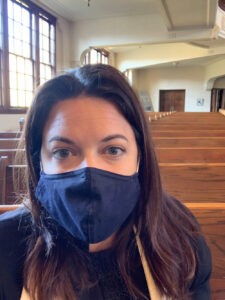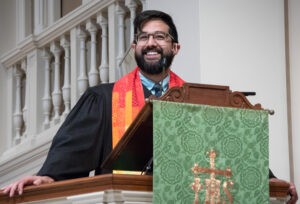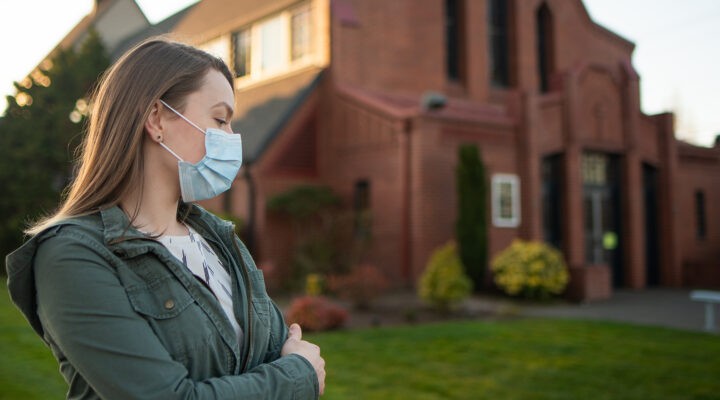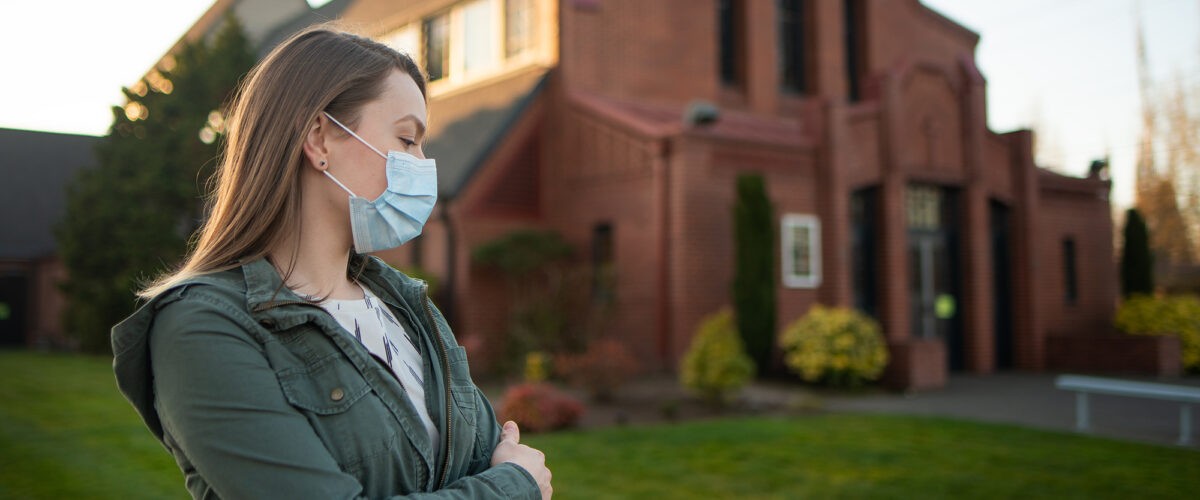It took a couple of years, but Elizabeth Mangham Lott finally hit her bottom with doing online church by the end of January.
“Y’all, this Zoom church stuff is crushing me today. I don’t wanna do it. And I don’t wanna say meaningful things into a green dot on my laptop. If we aren’t gathering for real, then I just really want a Galette des Rois from Celtica French Bakery and a second cup/pot of coffee,” Lott, senior pastor of St. Charles Avenue Baptist Church in New Orleans, posted on Facebook Jan. 30.
By mid-February, Lott said she realized that only 20 of her church’s 100 Sunday services since the outbreak of COVID-19 had been held in person. Of those, only eight took place in the sanctuary, with barely 40 to 50 people in the room each time. Currently the church is holding online-only services.

Early in the pandemic, Elizabeth Mangham Lott sat in the historic sanctuary of St. Charles Avenue Baptist Church in New Orleans.
“I am feeling every one of those 100 Sundays with only eight of them in our space,” she said. “We have not been back to normal, and we have not had a choir, since March 8, 2020. We have had a cantor who wears a mask while singing. There have been some moments of preaching when I feel like I’m in the groove, but even then, there was no feedback. It’s hard to generate empathy and compassion and talk about equity and justice and speak from the heart and then just close your computer.”
Lott said her church has been especially cautious throughout the pandemic, inspired partly by the guidance of two epidemiologists and many senior adults in the congregation.
In the early weeks and months of the pandemic, she said, there was some excitement around worshiping online and later in hybrid settings. But eventually it all became monotonous.
“I have watched so many people in moderate and progressive Baptist life leave church jobs over the past 22 months, and I have not wanted to be in that number, and part of the way I avoid that is telling the truth about how it’s affecting me,” she said.
To do otherwise would feel like lying or pretending and today she wonders “are we ever going back to normal? Or have things changed forever?”
Research has demonstrated that Lott is not alone in asking those questions.
A November 2021 study by the Hartford Institute for Religion Research confirmed that virtual worship and other gatherings quickly became the norm across the church world beginning in the previous year.
“Thanks in part to this reality, we find that an overwhelming majority of congregations, 80%, are offering hybrid services with both in-person and remote options, 15% of congregations are solely worshiping in person and only 5% of congregations are continuing to solely worship virtually.”
The trend had an emotional impact on many ministers, the study found. “Two-thirds of clergy (67%) have thought at least once in the past 12 months that this was the hardest year of their ministry, with 12% and 17% having this thought fairly or very often.”
A November 2021 Barna Group study reported that 38% of pastors considered leaving ministry. “This percentage is up 9 full points (from 29%) since Barna asked church leaders this same question at the beginning of 2021.”
Brent Newberry said he hit that wall himself during the pandemic.

Brent Newberry
“I can relate, absolutely. I was tired of Zoom worship. It was great for a while, until it wasn’t. Then it just got stale,” said Newberry, pastor of First Baptist Church of Worcester, Mass.
Newberry’s congregation was fully virtual in its gatherings through the spring of 2021 before undertaking a series of on-again, off-again hybrid gatherings, some of them outdoors. Technical challenges plagued the process of attempting to make the services simultaneously enjoyable to online and in-person worshipers.
“Then the astronomical spike of the Omicron variant hit, and we were back to being fully online again,” he said.
That emotionally draining reality began to shift for the better when Newberry began experimenting with new online and in-person elements of worship.
Those included a large-screen display in the sanctuary to enable those in the pews to see online worshipers. A candle-lighting portion was added to the live service and virtual attendees were enabled to submit prayer requests visible to those physically present.
“I started to find more energy for myself as I led a congregation through something that was being engaged, whether they were in the sanctuary or connecting online,” he said.
Newberry also created a “homitilurgical” preaching and teaching approach in which his pre-recorded messages narrate a series of still photos and video clips. While providing variety to those in the pews and online, it also cut down on having to speak into a light on his computer.
Church members also are invited to submit short video clips that can be edited into a message for a given Sunday. This has been especially helpful as the church is once again worshiping online only.
“I’m energized by people who can see one another again, whether they are at home or in church, and I am energized by their engagement,” Newberry said. “And it brings me a lot of excitement to balance all those efforts.”
Related articles:
Most comprehensive study yet of COVID’s impact on churches finds uneven results
Leaving church, part 2: The Great Baptist Resignations and COVID | Analysis by Carol McEntrye and Pam Durso
Four common approaches to church after COVID separation | Opinion by Mark Tidsworth


